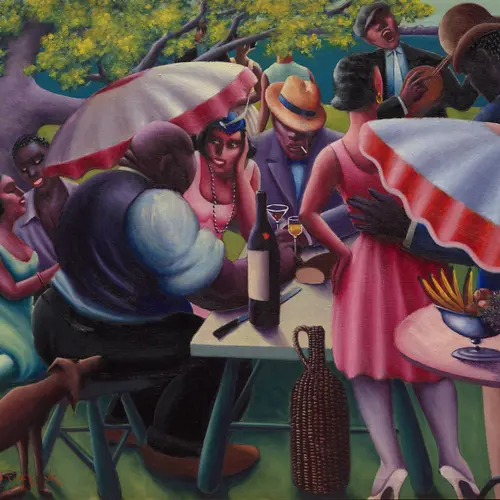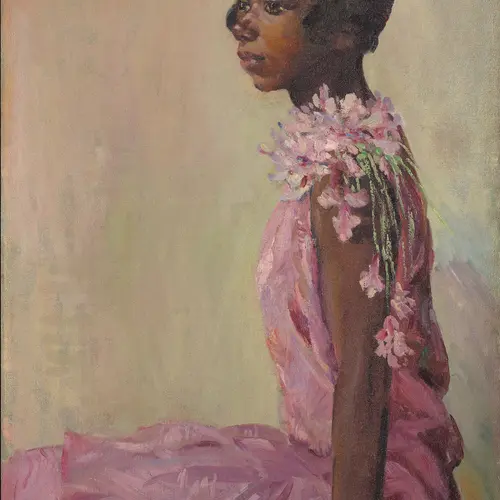The Met announces major Harlem Renaissance exhibition

Archibald J. Motley, Jr. (American, 1891–1981), Black Belt, 1934, Oil on canvas, Framed: 33 in. × 40 5/8 in. × 1 3/4 in. (83.8 × 103.2 × 4.4 cm), Collection of the Hampton University Museum, Hampton, Virginia, © Estate of Archibald John Motley Jr. All reserved rights 2023 / Bridgeman Images Image courtesy Hampton University
The Metropolitan Museum of Art next year will host an exhibition establishing the Harlem Renaissance as the first-ever African-American-led international art movement. Debuting in February 2024, “The Harlem Renaissance and Transatlantic Modernism” will explore the ways in which Black artists depicted everyday life in the new Black cities that developed across the United States from the 1920s through the 1940s, like New York City’s Harlem and Chicago’s South Side. As the first art museum survey of the Harlem Renaissance in the city since 1987, the exhibition includes roughly 160 works of painting, sculpture, film, photography, and more.

The art featured in the exhibition was created during the beginning of the Great Migration, a time in which millions of African Americans moved north out of the segregated rural South.
The exhibition will open with galleries that depict the “cultural philosophy” that influenced the blossoming of the New Negro art and literature movement, a term coined by Howard University professor Alain Locke. The galleries put an emphasis on Black artists who refused to depict the Black subject using the racist stereotypes of the time and instead portrayed them in a radically modern way.
The exhibition continues with galleries featuring paintings, sculptures, film projections, photography from the Met’s recently acquired James Van Der Zee Archive, and art from the covers of books and periodicals like the NAACP’s Crisis and the National Urban League’s Opportunity: A Journal of Negro Life.

Found throughout the exhibition are pieces that exemplify the New Negro movement’s approach to portraying social issues like queer identity, colorism, class tensions, and interracial relations. The exhibition will end with a gallery highlighting artists’ treatment of social justice issues as the New Negro movement came to an end during the start of the Civil Rights Movement in the 1950s.
“The Block,” a 15-foot-wide series of collages created by Romare Bearden, will serve as a coda for the exhibition. The work, part of the Met’s collection, is influenced by the rows of townhouses in mid-20th century Harlem and continues the legacy of the Harlem Renaissance.
While all of the featured artists shared the same sentiments of accurately portraying aspects of Black life and culture, each developed their own distinct style, ranging from African and Egyptian influences to European avante-garde stylistic choices.

28 × 22 in. (71.1 × 55.9 cm), The Metropolitan Museum of Art, Purchase, Lila Acheson Wallace Gift and George A. Hearn Fund, 2021, © Estate of Charles Henry Alston
“This landmark exhibition reframes the Harlem Renaissance, cementing its place as the first African American–led movement of international modern art,” Max Hollein, the Met’s Marina Kellen French Director and CEO, said.
“Through compelling portraits, vibrant city scenes, and dynamic portrayals of night life created by leading artists of the time, the exhibition boldly underscores the movement’s pivotal role in shaping the portrayal of the modern Black subject—and indeed the very fabric of early 20th-century modern art.”
As part of the exhibition, a gallery featuring paintings by New Negro artists who worked and lived in Europe for extended periods of time will be purposely set against depictions of the African diaspora by Black and white European artists, including Pablo Picasso, Henri Matisse, Edvard Munch, Germaine Casse, Kees Van Dongen, Jacob Epstein, and Ronald Moody.

Many of the featured paintings, sculptures, and other art pieces have been sourced from the collections of Historically Black Colleges and Universities, including the Clark Atlanta University Art Museum, Fisk University Galleries, Hampton University Art Museum, and the Howard University Gallery of Art. Other contributors to the exhibition include the Smithsonian American Art Museum and the National Portrait Gallery.
Artists whose work is presented in the exhibition include Charles Alston, Miguel Covarrubias, Aaron Douglas, Meta Warrick Fuller, William H. Johnson, Archibald Motley, Jr., Winold Reiss, Augusta Savage, James Van Der Zee, and Laura Wheeler Waring.
“Many New Negro artists spent extended periods abroad and joined the multiethnic artistic circles in Paris, London, and Northern Europe that shaped the development of international modern art,” Denise Murrell, the Met’s Merryl H. and James S. Tisch Curator at Large, said.
“The exhibition underscores the essential role of the Harlem Renaissance and its radically new modes of portraying the modern Black subject as central to the development of transatlantic modern art.”
The exhibition will open on February 25, 2024 and run through July 28, 2024.
RELATED
Explore NYC Virtually
Leave a reply
Your email address will not be published.



































[…] https://www.6sqft.com/the-met-announces-major-art-exhibition-on-harlem-renaissance/ […]